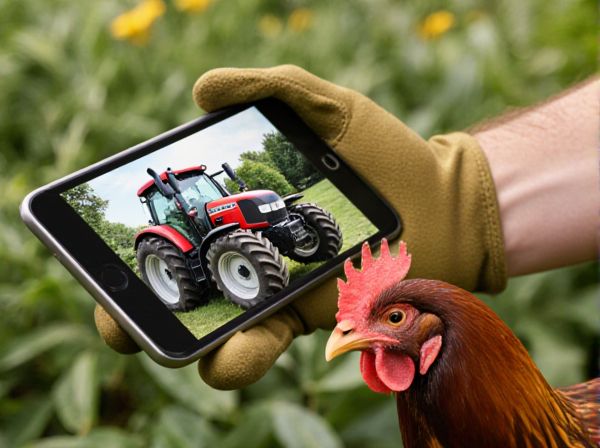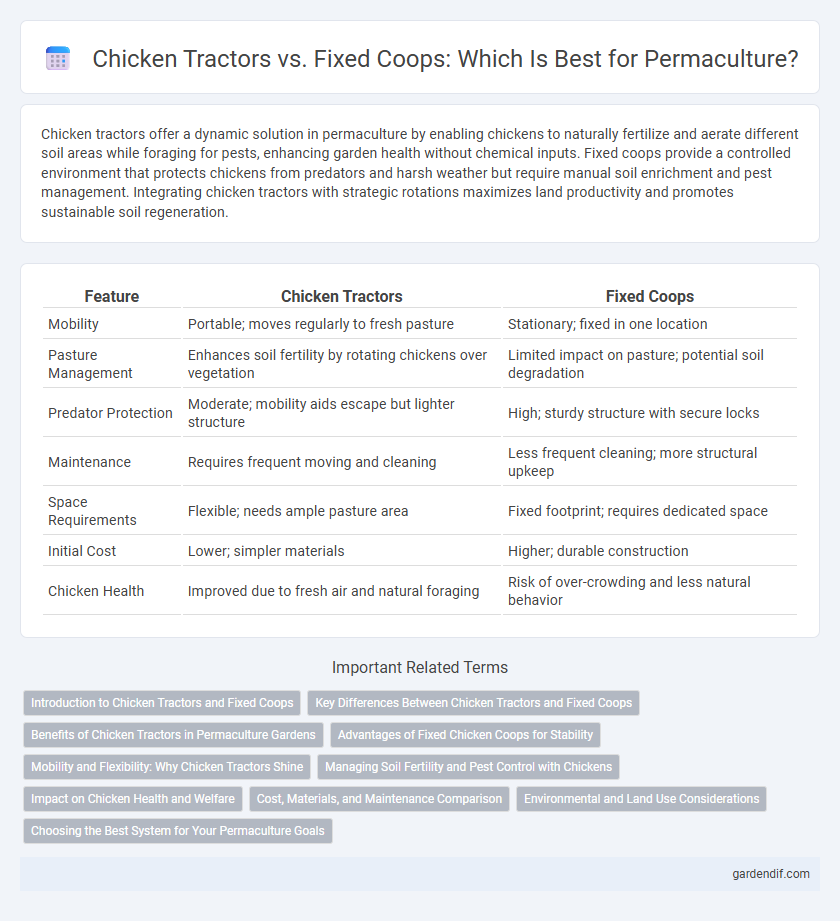
Chicken tractors vs fixed coops Illustration
Chicken tractors offer a dynamic solution in permaculture by enabling chickens to naturally fertilize and aerate different soil areas while foraging for pests, enhancing garden health without chemical inputs. Fixed coops provide a controlled environment that protects chickens from predators and harsh weather but require manual soil enrichment and pest management. Integrating chicken tractors with strategic rotations maximizes land productivity and promotes sustainable soil regeneration.
Table of Comparison
| Feature | Chicken Tractors | Fixed Coops |
|---|---|---|
| Mobility | Portable; moves regularly to fresh pasture | Stationary; fixed in one location |
| Pasture Management | Enhances soil fertility by rotating chickens over vegetation | Limited impact on pasture; potential soil degradation |
| Predator Protection | Moderate; mobility aids escape but lighter structure | High; sturdy structure with secure locks |
| Maintenance | Requires frequent moving and cleaning | Less frequent cleaning; more structural upkeep |
| Space Requirements | Flexible; needs ample pasture area | Fixed footprint; requires dedicated space |
| Initial Cost | Lower; simpler materials | Higher; durable construction |
| Chicken Health | Improved due to fresh air and natural foraging | Risk of over-crowding and less natural behavior |
Introduction to Chicken Tractors and Fixed Coops
Chicken tractors are movable enclosures that allow poultry to forage on fresh ground while providing protection from predators, promoting soil fertility through natural fertilization and pest control. Fixed coops offer a permanent, sturdy shelter that simplifies maintenance and provides consistent protection but limits natural foraging opportunities and soil enrichment. Both systems support sustainable permaculture practices, with chicken tractors enhancing land regeneration and fixed coops ensuring stable housing.
Key Differences Between Chicken Tractors and Fixed Coops
Chicken tractors are movable enclosures that allow chickens to forage on fresh ground, promoting soil health and reducing parasite buildup, while fixed coops provide a permanent sheltered space with controlled environments for laying and protection against predators. Chicken tractors typically require daily relocation to optimize pasture use, whereas fixed coops rely on static bedding and manual cleaning to maintain hygiene. The flexibility of chicken tractors supports rotational grazing systems, whereas fixed coops are better suited for intensive egg production with consistent flock management.
Benefits of Chicken Tractors in Permaculture Gardens
Chicken tractors enhance permaculture gardens by providing mobile pest control and natural fertilization, as chickens scratch and aerate the soil while consuming insects. Their portability allows targeted soil enrichment and weed management without damaging fixed garden beds. This method promotes sustainable soil health and improves plant growth by mimicking natural ecological cycles.
Advantages of Fixed Chicken Coops for Stability
Fixed chicken coops provide superior structural stability, ensuring protection from predators and harsh weather conditions due to their solid construction and permanent foundation. Their fixed location supports consistent temperature control and easier installation of controlled ventilation systems, promoting healthier living environments for poultry. This permanence also facilitates efficient waste management and long-term integration into permaculture designs, contributing to soil fertility and ecosystem stability.
Mobility and Flexibility: Why Chicken Tractors Shine
Chicken tractors provide superior mobility and flexibility compared to fixed coops, allowing poultry to access fresh pasture daily and reduce soil compaction. Their lightweight design and manageable size enable easy relocation, promoting healthier foraging opportunities and natural pest control. This dynamic movement supports sustainable land use and enhances overall flock well-being.
Managing Soil Fertility and Pest Control with Chickens
Chicken tractors enhance soil fertility by allowing chickens to naturally fertilize and aerate rotating soil, promoting microbial activity and nutrient cycling. Fixed coops limit chickens to one area, often leading to compacted soil and uneven nutrient distribution, which can hinder plant growth. Using chicken tractors supports pest control by enabling targeted grazing of insects and larvae, reducing pest populations without chemicals.
Impact on Chicken Health and Welfare
Chicken tractors promote better chicken health and welfare by providing constant access to fresh forage, natural sunlight, and ample space for exercise, reducing the risk of diseases and stress-related behaviors. Fixed coops, while easier to manage, often limit movement and increase exposure to parasites and ammonia buildup, potentially leading to respiratory issues and feather damage. Regularly moving chicken tractors ensures cleaner living conditions and enhances overall bird vitality compared to static environments.
Cost, Materials, and Maintenance Comparison
Chicken tractors offer a cost-effective alternative to fixed coops by utilizing lightweight, portable materials such as wire mesh and wood, reducing initial investment and allowing movable pasture access. Fixed coops often require more durable, weather-resistant materials like treated lumber and metal, resulting in higher upfront costs but increased long-term structural stability. Maintenance for chicken tractors centers on frequent cleaning and relocating to fresh ground to prevent disease, while fixed coops demand more routine repairs and sanitation within a static environment.
Environmental and Land Use Considerations
Chicken tractors enhance soil fertility and reduce land degradation by allowing chickens to forage and naturally aerate the ground in rotated grazing areas. Fixed coops concentrate waste in one spot, requiring more intensive management to prevent soil contamination and limit vegetation damage. Utilizing chicken tractors supports sustainable land use and promotes ecological balance within a permaculture system.
Choosing the Best System for Your Permaculture Goals
Chicken tractors enhance soil fertility and pest control by allowing chickens to naturally forage and fertilize rotating garden areas, aligning with dynamic permaculture principles. Fixed coops offer stable shelter and easier management of chickens but may limit natural behaviors and require supplemental feeding and cleaning. Selecting between these systems depends on balancing soil health goals, resource availability, and desired labor input within the permaculture design framework.
Chicken tractors vs fixed coops Infographic

 gardendif.com
gardendif.com